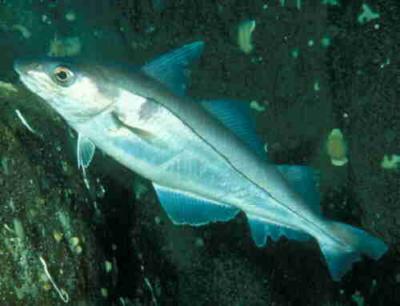 SKC Films Library SKC Films Library |
| SKC Films Library >> Science >> Zoology >> Fishes >> Class Actinopterygii |
| Haddock Melanogrammus aeglefinus Description The haddock is a medium-sized fish, with a maximum length of 44 inches and maximum weight of about 36 pounds. It is distinguished from other members of the cod family by its three dorsal fins, a small barbel on the chin, and most importantly by the dark patch on the flank just behind the gills. It also has a distinguishing think black line that runs from the head to the tail.
Distribution and Habitat Haddock are found on both sides of the North Atlantic, and in the Arctic. On the European side it becomes less numerous from the North Sea through the English Channel and into the Bay of Biscay. On the American side it is most numerous from Newfoundland south to off the New England coast. Reproduction Haddock spawn from mid-January to mid-June, with a peak from the middle of February to the middle of March. Males compete for females by facing off against each other and making threatening displays until one or the other backs down. The female then approaches the "winner," the two engage in a brief courtship ritual, and she then begins depositing her eggs while the male simultaneously deposits his milt. The pair may spawn a dozen or more times over a period of a couple of weeks, with an interval of about one day between each spawn. Up to 200,000 or more eggs may be deposited by one female in a breeding season. Eggs are about 1/20 inch in diameter and float some way off the bottom, at an average depth of about 300 feet. The young fishes remain in mid-water until they are about two inches long, then become bottom feeders. Diet Adult haddock feed on a variety of bottom-dwelling animals, including crustaceans, shellfish, sea-urchins, and worms, and will also gorge themselves on herring eggs when given the chance. Scientific Classification phylum Chordata SOURCE |
| SKC Films Library
>> Science
>> Zoology >> Fishes >> Class Actinopterygii This page was last updated on June 17, 2017. |
